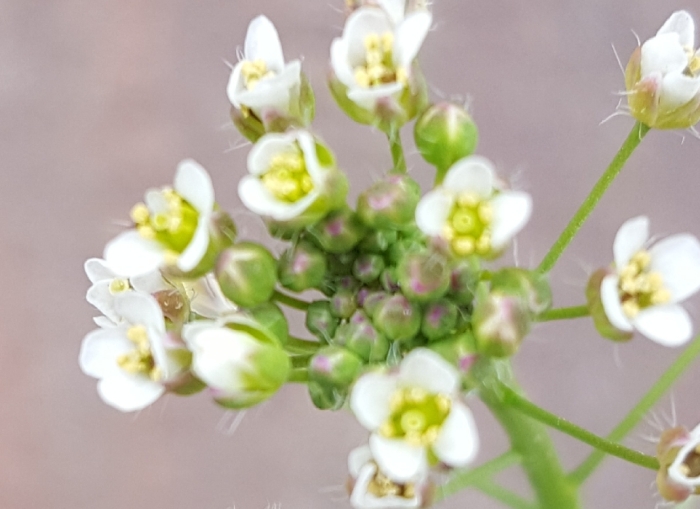Shepherd’s Purse
(Capsella bursa-pastoris)
Shepherd’s Purse (Capsella bursa-pastoris)
/
/

© Ingimar
CC BY-SA 4.0
Image By:
© Ingimar
Recorded By:
Copyright:
CC BY-SA 4.0
Copyright Notice:
Photo by: © Ingimar | License Type: CC BY-SA 4.0 | License URL: http://creativecommons.org/licenses/by-sa/4.0/ | Uploader: ingimar | Publisher: iNaturalist |
























Estimated Native Range
Summary
Capsella bursa-pastoris, commonly known as shepherd’s purse, is an annual herb that is native Europe and Asia but has become naturalized globally, often found in disturbed soils of fields, roadsides, and gardens. It typically grows from a basal rosette of deeply lobed leaves, with a flowering stem that can reach up to 20 inches tall. This plant is characterized by its small, white, four-petaled flowers and distinctive heart-shaped seed pods. Shepherd’s purse is notable for its extended flowering season, which can occur almost year-round, depending on the climate. The seeds of this plant have protocarnivorous properties, which means they can attract and kill nematodes—a feature that is quite unique among plants.
Shepherd’s purse is valued for its medicinal properties, as it has been used traditionally to stop bleeding and as a diuretic. It is also edible, with young leaves that can be added to salads or cooked as greens. In cultivation, it prefers full sun to part shade and thrives in a variety of soil types, though it is commonly found in poor, compacted soils. It requires minimal water once established and is often considered easy to maintain due to its ability to self-sow. However, its prolific seed production and ability to spread quickly make it potentially invasive in some regions, so caution is advised when planting it outside its native range.CC BY-SA 4.0
Shepherd’s purse is valued for its medicinal properties, as it has been used traditionally to stop bleeding and as a diuretic. It is also edible, with young leaves that can be added to salads or cooked as greens. In cultivation, it prefers full sun to part shade and thrives in a variety of soil types, though it is commonly found in poor, compacted soils. It requires minimal water once established and is often considered easy to maintain due to its ability to self-sow. However, its prolific seed production and ability to spread quickly make it potentially invasive in some regions, so caution is advised when planting it outside its native range.CC BY-SA 4.0
Plant Description
- Plant Type: Herb
- Height: 0.5-1.5 feet
- Width: 0.5-1.5 feet
- Growth Rate: Moderate
- Flower Color: White
- Flowering Season: Spring
- Leaf Retention: Deciduous
Growth Requirements
- Sun: Part Shade
- Water: Low, Medium
- Drainage: Medium
Common Uses
Edible*Disclaimer: Easyscape's listed plant edibility is for informational use. Always verify the safety and proper identification of any plant before consumption., Low Maintenance
Other Names
Common Names: Shepard’s Heart, Capsella
Scientific Names: , Capsella bursa-pastoris, Bursa abscissa, Bursa alandica, Bursa anglica, Bursa astoris, Bursa batavorum, Bursa belgica, Bursa bremensis, Bursa brittonii
GBIF Accepted Name: